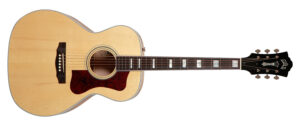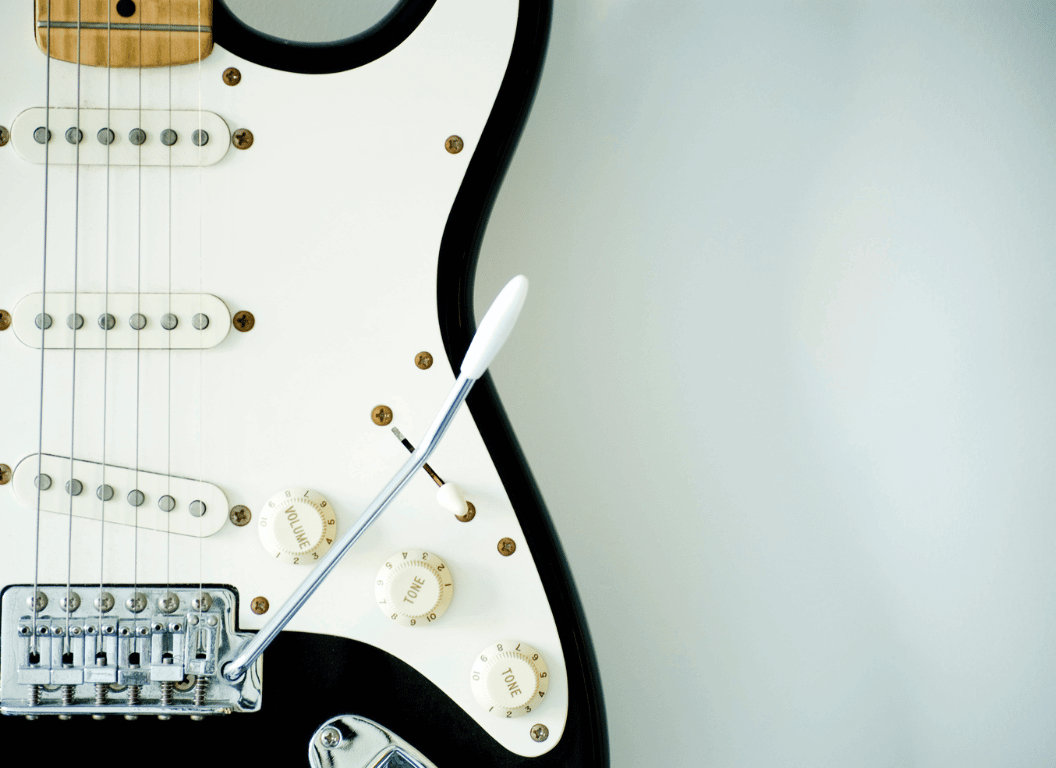How to choose the best guitar for your child? Buying a guitar for the first time can be very hard if we do not know what we are really looking for in the first place.
Should you buy an electric guitar or an acoustic guitar? What size should you choose? What type of strings?
All these questions will obviously arrive at some point, and if we really don’t know much, we won’t be able to make the right choice at all.
Therefore, picking the perfect guitar for a child is not as easy as it seems.
But…
Here are some tips on how to choose a guitar for your child and actually buy something that will make it easy for them to play.
Let’s get started!
Table of Contents
- How to Choose a Guitar for Your Child?
- 1- Choose the right type of guitar: Classical, Acoustic or Electric
- 2- Pick a size that will make it easy for them to learn
- 3- Research each brand before buying
- 4- Decide whether to use nylon strings or steel strings
- 5- Ask your child about their own favorite guitar
- 6- Make sure that the guitar has been adjusted accordingly
- 7- Pay attention to the design of the guitar
- Should you buy a ukelele instead?
- Could you just let children decide for themselves?
- How much money should you spend on a beginner guitar?
- What guitar size is best for beginners?
- What is the best age for a child to learn guitar?
How to Choose a Guitar for Your Child?
In order to choose the best guitar for your child, you should look for one that has a size proportional to your child’s age and height, and at the same time, you must not ignore their wishes in terms of style, color, and type of guitar. Sometimes, kids develop a passion for an instrument after seeing somebody play, or in an attempt to mimic a popular guitar player. In such cases, they will want to buy the exact gear that said musician has or something that’s close enough; this should be allowed.
As we said before, this process is not as easy as it seems, but you could also simplify it by knowing the right things before making a choice.
We will be talking about everything that you should have in mind, and also the most common mistakes that people usually make when buying beginner guitars.
1- Choose the right type of guitar: Classical, Acoustic or Electric
This might be the most confusing part about buying a guitar for your child. Which type of guitar should you really buy in the first place?
There are many different types of guitars, but we will only be covering three of them.
Classical Guitars
The classical guitar is an acoustic wooden string instrument with strings made of nylon.
You should know many things about this specific type of guitar, like its size, the type of sound that it makes, or even the type of music that people usually play.

But, just for the sake of simplicity, just know that the fretboard is wider, which could be good or bad depending on how big the child’s hands are.
And also know that nylon strings are usually better for beginners since they do not hurt as much as steel strings, and classical guitars always come with nylon strings.
Take a look at this YouTube video of Michael Lucarelli playing “Malagueña” for example:
As you can see, the music that is played on classical guitars generally requires a lot of arpeggios and hand coordination.
In my opinion, this is a skill that is better developed with this type of guitar.
But, at the same time, almost any type of music could be played with almost any type of guitar.
Acoustic Guitars
An acoustic guitar is a guitar that produces sound acoustically by “transmitting the vibration of the strings to the air”.
“The sound waves from the strings of an acoustic guitar resonate through the guitar’s body, therefore creating sound.”
From that definition, you can say that it’s almost the same as a classical guitar. But let’s keep talking about it to see why that statement is not as simple as it seems.

Although metal strings are usually the ones that come with this type of guitar, there is something you should know:
You could also put nylon strings on any guitar that originally comes with steel strings.
Personally, that was how I learned to play the guitar.
I had a very small acoustic guitar that originally had steel strings, but I simply replaced them with nylon strings until I became comfortable and had the right technique (applying the right pressure to the strings, for example).
That was when I really started playing with steel strings, and even then, it was a completely different experience that took me a few days to get used to it.
If you are interested in hearing how acoustic guitars sound, you should watch this YouTube video by Darek Wawrzyniak in which he does a demo a Fender CF-60:
As you can see from the video, you could use arpeggios as well, and even play any song that would usually be played with classical or electrical guitars.
Now, let’s take a look at electric guitars.
Electric Guitars
An electric guitar is simply a guitar that makes use of one or more pickups to make the vibration of its strings into electrical signals.
The vibration happens when a guitarist strums or fingerpicks the strings.

Electric guitars have a huge advantage over classical and acoustic guitars when it comes to beginners:
You can use headphones to only hear yourself when practicing through an amp.
When it comes to the tone and sound that the guitar will make:
Take a look at this YouTube video by WGBH Music, in which they talk about the difference between clean and dirty tone:
As you can hear, an electric guitar could also sound like an “acoustic” guitar, which simply is a clean tone.
Now…
Since all three of the guitar types that we talked about, sound different when played, and fit into different genres of music, you might feel confused as to which one is the right choice.
Which one should you choose?
Simply think about the type of music that your child might be interested in learning and playing.
As I said before, my personal journey was as follows:
I had an acoustic guitar with nylon strings, and then eventually moved to steel strings, and from that, I got myself into electric guitars.
If there is something I am grateful for, it’s how versatile it made me, since I got to experience what it was to play each and every single one of them.
2- Pick a size that will make it easy for them to learn
Another important step in buying a guitar for your child is finding the right size.
If your child is primarily between the ages of 4 to 6, you should opt for the smallest guitars because it will be easier for them to maneuver and play.
For example, their hands might not be big enough to play chords, etc.
The more comfortable your son or daughter feels holding the guitar, the better they will learn to play the instrument.
One: because of how motivated they will feel, and two: because they will actually be able to see some progress eventually.
These are the guitar sizes that you should be looking into according to your child’s age:
30” for ages 4-6
34” for ages 6-9
36” for ages 9-12
Standard for 12 and up
3- Research each brand before buying
Although your child will be in the learning stages of playing the guitar, it is still good to consider various brands before you make your final purchase.
What we mean by this is, many brands will make similar guitars with almost the same material, color, size, etc.
But…
It is your job to go the extra mile and see what they primarily focus on when they make their guitars.
Each company will always have one little thing that makes it special, and you need to find that out among your top options when buying a guitar.

A good brand can have a serious impact on sound and playing.
Meanwhile, different brands also have different prices.
After considering different options, you should also pick the one that suits your budget and helps your child learn to play guitar with ease.
4- Decide whether to use nylon strings or steel strings
We talked about this earlier.
There is so much to know about strings and the different types that exist today, that a simple article would not do justice.
But…
Just know that when it comes to a beginner, in my opinion, nylon strings are better.
I could be wrong or I could be totally right on this one, but this was just my own personal experience.
Since I struggled to play with steel strings, I made a switch to nylon strings since they are easier to play, and do not hurt as much.
Later, after I started becoming aware of the right techniques that I should always have in mind when playing, I made the change back to steel strings, and it was not as bad as it was at the beginning of my learning journey.
The interesting thing is, that you could have a classical guitar with steel strings, and an acoustic guitar with nylon strings.
Is this how it is supposed to go?
Well…
Technically no.
Classical guitars come with nylon strings, and acoustic guitars generally have steel strings.
The point is, that even though is not the “standard”, you could still do it just for the sake of not limiting your options and helping the child learn without struggling.
At the end of the day, every decision should be made for the well-being of the guitarist and to make them feel comfortable.
5- Ask your child about their own favorite guitar
Of course, the best thing in such situations as this is to take your child with you to a guitar store.
Many places if not all, should let customers try the guitars before buying them, so your child can check if they are comfortable or not.
You should allow your child to pick the guitar, but at the same time, paying attention to all the necessary precautions to not make them struggle in the future.

One thing to notice is, that children usually pick guitars based on their favorite guitar player, or who they are trying to imitate.
This is perfectly fine, as long as, again, you pay attention to the size of the guitar, etc.
6- Make sure that the guitar has been adjusted accordingly
Now, this is something that should never be ignored when buying a guitar.
It is more of a life hack than it is of advice.
Your child will do better at learning if the guitar is well-adjusted.
For instance, strings should be close enough to the fingerboard, just so they will not have to pressure too much to make a sound.
This comes back to what we talked about before with nylon vs steel strings.
The same thing will happen, our fingertips will hurt if we need to do that extra work to press on each string.
7- Pay attention to the design of the guitar
While playing the guitar itself is already an interesting thing to do, color and design can be important for your child.
It is more appealing to choose striking colors for more energetic children whereas you can pick sober shades for children who like browns and dark colors.
Some guitars also have prints, floral patterns, etc. which can be intriguing for your child as well.

In short, you know your child the best so pick the one that you think they are going to love.
Essentially, this is more of a physiological trick.
They will be more inclined to learn to play if they actually like the guitar’s design, at least that was the case with many of the guitarists that I know.
Should you buy a ukelele instead?
Now, for those that do not really know what a ukelele is:
The ukulele or ukelele is a member of the guitar family of instruments that generally employs four nylon strings.
One of the features that make this instrument so unique is its size.

Since it is usually a very small instrument, some consider it more convenient for children to play it.
Have in mind, that a ukelele is like play a regular guitar, but just with its four lower strings and with a capo on the 5th fret.
Take a look at this YouTube video of a kid that went viral with his ukelele videos and ended up playing on Ellen (skip to 3:07 for the actual performance):
As you can see, you can still play any song on a ukelele, and it will sound good.
Just consider it another option, but always know that just because it has some similar features of an actual guitar, it will not have the same sound or tone as an actual guitar.
Could you just let children decide for themselves?
This is actually a very interesting way to go about buying a guitar for your child.
Just let them decide whatever guitar they want, and simply buy it.
Do know that if the guitar it’s too big though, they will struggle to play it.
But…
On the other hand, they will always be very motivated to at least try.
In my opinion, you should always make sure that they pick something that will actually benefit them in the future.
But at the same time, yes, also let them choose whatever guitar they want.
How much money should you spend on a beginner guitar?
This depends on you and your budget.
You could spend thousands of dollars, or you could spend $30 on a guitar.

When it comes to a beginner guitar, I would say get a decent guitar first, and right after the child has learned to play it, simply buy something of higher quality.
At the end of the day, it is more of a personal choice that you need to take depending on how much money you are really willing to spend.
What guitar size is best for beginners?
For beginners, the size is very important, and not so important at the same time.
Let me explain myself…
If you have ever made a quick YouTube search for kids playing the guitar, you might have noticed that some of them play full-sized guitars without any struggle.
That right there is most of the answer anyone could give you.
It really depends on the person playing itself, the size of their hands, and how comfortable they feel at all times.
As a rule of thumb, always make sure that they see the guitar themselves before buying it.
This will allow them to take a look at whether it would be hard for them to start learning or not.
Also, there is nothing wrong with buying smaller guitars!
That’s how I started to learn, personally. And as time passed, I bought bigger guitars.
Here’s a small table that could potentially help you make better decisions:
| Guitar Size | Overall Length | Age |
| 1/4 | ~ 30″ | 4-6 years |
| 1/2 | ~ 34″ | 5-8 years |
| 3/4 | ~ 36″ | 8-11 years |
| 7/8 | ~ 39″ | 10 years and older |
| 4/4 | ~ 40″ | 12 years and older |
What is the best age for a child to learn guitar?
The best age for a child to start learning is anywhere above 4 years old.
It is around that time, that they could start having some interest in the instrument.
Of course, not everybody is the same, so some children might also not be able to play the guitar successfully until when they’re 10 or older.

Dad, husband, son, and guitarist. I’ve been playing guitar for 20 years. Passion for writing, painting, and photography. I love exploring nature, and spending time with my family. Currently have a Gretsch G5220 Electric Guitar as my main instrument.




